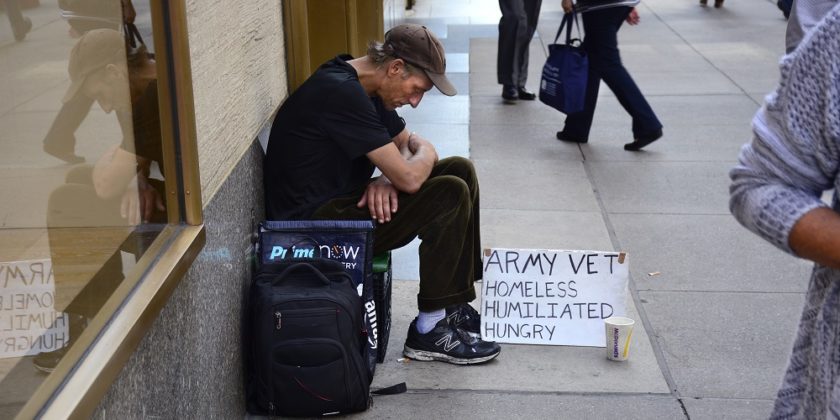 I am currently a student at Western Washington University. From the class on social stratification, I and my group decided to do a research on inequalities among U.S. retired and active-duty military members. We found surprising statistics that indicate the severity of the inequities that veterans face. This is my second post in a series of four on what we found. You can read part I here. Homelessness 76,000 veterans are on the streets on any given night, which counts as 12.3 percent among the total homeless adult population in the U.S., according to the US Department of Housing and Urban Development. Taking a closer look into a survey of 5,794 veterans examining housing instability, 4,934 (85 percent) experienced brief instability, and 850 (15 percent) experienced ongoing instability. Instability in this case included homelessness, difficulty in paying for housing, frequent moves, and frequent moves with patterns of increased health and health care issues. Does government give enough? The brief answer would be no. Just like every living human being, veterans need secure housing, nutritional meals, and basic physical health care. Additionally, veterans need job assessment, training, and placement assistance for transitioning into the workforce after they serve. However, there is an extreme lack of help from the U.S. Department of Veterans Affairs. Among the 18.8 million veterans in the United States, only 9 million are able to be served by the Department of Veterans Affairs. For housing, the Department of Veterans Affairs (VA), using its own resources or in partnership with others, has secured nearly 15,000 residential rehabilitative and transitional beds and 30,000 permanent beds for homeless veterans throughout the country. This only covers about 3 percent of the total veteran population facing the risk of being homeless (total population at risk: 1.4 million). For meals, nearly 3 million veterans and their families don’t have enough to eat each month. More than 25 percent of veterans reported food insecurity in the past calendar year, with 12 percent reporting “very low food insecurity.” The VA’s specialized homelessness program provides healthcare to 150,000 homeless veterans and other services to 112,000 veterans, which covers about 5-7 percent of the veteran population facing being homeless and broke. Almost 2 million veterans are living without health insurance along with 3.8 million members of their households. Among uninsured veterans, 25 percent said they couldn't get medical care because of costs, 30 percent delayed care due to costs, and 50 percent hadn't seen a doctor within the past year. Interestingly, one study found that veterans are significantly less likely to be accessing community clinics; instead, they rely on shelter clinics and street outreach for medical care. The Washington Post and Kaiser Family Foundation conducted a nationwide poll of veterans from the wars in Iraq and Afghanistan. Half of the respondents in the poll said their readjustment to civilian life was difficult, and 56 percent rated the job assessment help from the government as “not so good” or “poor” (to be noted, 51 percent of individual homeless veterans have disabilities). There is an extreme insufficiency from the VA’s support. Retired veterans continue to rely on the civilian welfare state to fill gaps, such as getting child welfare services and food stamps. Government money for veterans, while important, is very limited, and available services are often at maximum. It is highly critical, therefore, that community groups reach out to help provide support, resources, and opportunities from non-profit organizations. At the same time, we also should know the importance of advocating for better government spending for veterans instead of on new wars. In the next blog post, we will look at the issue of mental health that veterans experience after they serve. Written by Kexin ZengWWU student, Sociology Department. During my summer quarter at Western Washington University, I took a sociology class on social stratification which examines the social causes and consequences of inequality in America on the perspective of social distribution of wealth, power and status. For my group project near the end of the quarter, we chose veterans as our general topic, and we did our research on inequalities among U.S. retired and active-duty military members. We found surprising statistics that indicate the severity of inequities that veterans face. In a series of blog posts, I will share what we found. Nation of War The U.S. initiated the Iraq war from 2003 to 2011 and the Afghanistan war from 2001 to present. Currently, the U.S. is also participating in the Syrian war. Since the existence of the country, there have only been 20 years when this country was not participating in war. At $618.8 billion in 2016, military spending accounted for more than 53 percent of the federal discretionary budget. The U.S. leads the world in military spending. If you combine all of the military budgets of every country in this world, the U.S. has half of the total. There are 1,000 U.S. military bases worldwide. A Peek into the Veterans Homeless Population Boost after 9/11 Nearly half of veterans who are homeless served after 9/11. After the Vietnam War, it took 5-10 years for veterans to end up on the streets. There are 3.3 million veterans who have served since 9/11. Among veterans who are homeless, 47.6 percent are under the age of 35. It takes less than 3 months after discharge to end up on the streets. Along with homelessness, post 9/11 retired veterans have the highest percentage of service-connected disability, at 34.1 percent. In my next blog post, I will examine and demonstrate U.S. government’s role of addressing the issue of homelessness among veterans. Written by Kexin Cherie ZengWWU student, Sociology Department. |
Contributors
We invite the WPJC community to contribute fact-checked submissions on local, national and global current events. Linking to original sources and articles is required. Submissions may be sent to [email protected] for review. Categories
All
Archives
May 2024
|

 RSS Feed
RSS Feed